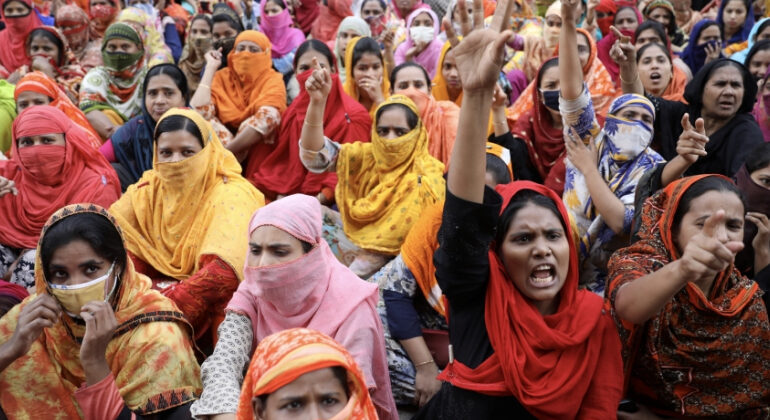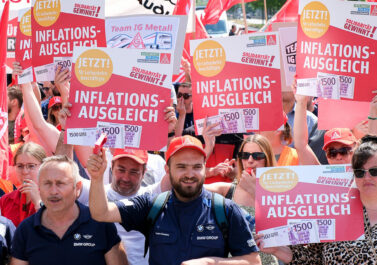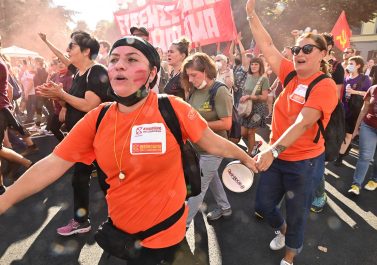Bangladesh: Garment workers fight! (original in German: Wildcat – May 2020)
You don’t need to know much about Bangladesh to understand that the Corona crisis will lead to extreme conditions locally. The virus came into the country through returning migrant workers, most likely from Italy. The health system is hardly prepared for health crises like this: there are only 1,170 intensive care beds for 170 million Bangladeshis. At the end of April, as far as can be estimated, there are still relatively few people who are ill or dead, but the trend is rising. Millions of people are already suffering from the economic effects. Garment exports have collapsed, and in general most businesses and shops have closed. Thousands of workers in Europe are not earning money to send back, and in Bangladesh many are stuck with confirmed visas and cannot leave the country to take up work.1
“Because of the pandemic, we can’t get a new job or leave our homes, which we can’t pay rent for anymore.”
For many, the lockdown means the loss of their income. According to a study by an NGO, the income of households which depend on what is officially classified as poverty wages fell by about 71 percent compared to February. On average, these households now spend 25 percent less on food. Sharply rising food prices reduce the amount of food people can afford to buy even further. In concrete terms, a normal rickshaw driver in February could still afford to buy the ingredients for six to seven portions of a (very) simple rice dish for four people from his daily income. By mid-April, it was not even two whole portions.2 In addition, by April 13 only four percent of the population had received any financial or material support at all.
“What’s the point of respecting the lockdown if you can’t eat?”
In Dhaka, hundreds of people protested several times in April for the distribution of food in their neighbourhoods. The aid measures put in place by the government, a significant amount of 8.9 billion dollars, are barely reaching the poor and the slums: the aid packages distributed by the army and NGOs are only a drop in the ocean. Most of the aid from the government or from NGOs is provided through money transfers, for which you need a mobile phone with credit (which many people cannot pay in the crisis) and a mobile phone connected bank account, which hardly anyone has. There are also frequent protests for the recognition as ‘essential workers’, for whom the government finances health insurance. Recently, customs officials have been campaigning to be included on this list. The biggest and most important protests so far have come from seamstresses in the garment industry. Like almost all workers, they face a double threat: the virus and the crisis that threatens their jobs.
The first factories closed at the beginning of March because orders were cancelled due to the government imposed closure of shops and department stores in the target countries and many large clothing companies such as Walmart, H&M and Primark refused to accept or pay for goods already produced. These are orders worth 3.17 billion dollars or one billion garments in 1,150 factories with 2.3 million workers (as of April 24). When there was an outcry by western media at the end of March, some large retailers were forced to promise to at least pay for the goods already produced and in production. But the losses are still massive, and many entrepreneurs have not passed these funds on to the workers.3
On March 26, most factories were then closed by government order until April 4. Many workers went to the countryside to save money. Although the government extended the lockdown, export factories with open orders were allowed to resume production. This led to a chaotic mass return of workers to the factory districts. Because large parts of the local transport network had been closed down, they came on foot, on bicycles and rickshaws, with horrendous costs for the individual workers. They came back under pressure from the employers, and fear for their jobs also played a role. But the main issue was the outstanding wages for the past months; in some factories not even the February wage had been paid in full. In view of the mass return journeys of workers required to re-start production, all factories were closed again with the threat of punishment if they did not adhere.4
“Stop the blackmailing by the bosses.“
The workers were now back in the cities – and of course, after the forced closure of the factory, the outstanding wages were not paid. At least 36 large export factories used the labour law in order to classify the closure as a ‘natural calamity’: according to this law the workers are then only entitled to 50 percent of wages and bonuses (and even that only for 45 days per year!). When work is resumed, the old employment contract continues to apply and the workers retain their previous wage level.
The pressure to fight back was great: after a survey of 88 seamstresses in all wage brackets at the beginning of April, 15 percent were broke and had to ask shops to give them credit, the rest only had cash for 16 days. One third reduced their purchase of food, 70 percent stopped sending money home, paying their rent or interest. 43 percent of those surveyed no longer have any money to buy mobile phone credit.
Without being restricted by the quarantine rules (which workers in cramped housing conditions with far too few sanitary facilities cannot comply with anyway), they organised protests in front of the factories, which frequently brought up to 20,000 people onto the streets from April 12. Usually between several hundred and a few thousand people gather in front of factories and call for the payment of wages and the withdrawal of the legal ‘natural calamity’ classification. The protests clearly showed the fighting experience of the last few years. Almost never do workers from one factory remain alone; there are always workers from other factories who join in. The workers from smaller factories especially become more visible.
Nevertheless, the current protests have a different character than in recent years. Obviously they are not strikes, but the composition is also different because there are fewer residents from the neighbourhood who had previously taken part in garment workers’ mobilisations. Often the protests blockade main streets and highways as a strategic tool. And they are more strongly accompanied by direct negotiations with the entrepreneurs, which are usually conducted indirectly by the local police or politicians. The protests are very orderly, even if sometimes a window or door is destroyed, they are actually peaceful. On the other hand, the police also rely more strongly on de-escalation than usual, after two workers ran in front of a truck in a panic during a tear gas operation in a protest on April 6 and died. Often the workers of many factories protested together, in Gazipur they came from at least 25 factories, in Ashulia from over 12 factories.
“Why do you give money to the employers and not to us?”
The protests were partially successful: 1200 factories paid the outstanding wages until April 15. The same day the government reacted with carrot and stick; at the same time as it made employers pay wages under threat of punishment, it also immediately provided loans to them worth 590 million dollars. By about April 20, over 96 percent of the 2.5 million workers in the certified export factories had received their wages. But no one knows how many of the remaining almost two million workers have not yet received their wages. By the beginning of May, the workers of at least 517 factories had not received their March wages.
Many people who have been laid off have not yet been taken back, in which case the workers are paid only half their wages, if at all. For this reason, the second half of April was also marked by protests for full wage payment and reinstatement or withdrawal of factory closures. However, these protests were much smaller (at their height, a few thousand per protest), partly because many workers went back to the countryside after having receiving their wages.
Bangladesh keeps on working
At the end of April, the lockdown was relaxed, the garment factories began to start up again, and by April 30 production was running in at least 2,000 factories. The main concern of the employers is to complete orders already in production, which they do not want to lose because the fashion companies might see this it as breach of contract. Although the bosses had promised to re-start production using only local workers, by the beginning of April many workers had made the arduous return journey from their villages, driven by the worry of missing out on the April wage which contains a significant annual bonus payment. Strong protests in the last days of April demanded full payment of wages despite the fact that the factories had been standing still for many days during April. At present, the workers seem to be less able to assert themselves on this point. The government decided that layoffs should be reversed and only 60 percent of the wages should be paid if no work was done. This would be a setback for the workers. The employers’ associations warned their members directly that they should not be pushed by the workers to pay the full April wage.
Other industries also increased production again: on April 26, for example, eight of nine jute factories in the Khulna region opened. In total, 30,000 workers are employed in these factories. Agriculture and passenger transport are also supposed to resume.
Corona as an accelerator of the crisis
Representatives of NGOs and trade unions (which are often de facto NGOs because of their small membership and their dependence on foreign funding) try to use the situation politically to persuade the government to establish a welfare state. In doing so they serve their own interests: more widespread use of bank accounts, more microcredit, more influence of trade unions on politics…
In a country like Bangladesh, where a quarter of the population lives below the official poverty line and where there are more than ten million day labourers and a great many informal workers, such a life-threatening crisis can hardly be ignored. Nevertheless, it is questionable whether there will be welfare state measures, and certainly not without strong workers’ struggles. Even before the pandemic, the economy was in an acute crisis: exports had fallen, as had the profits in agriculture. Prices for state goods had risen, but wholesale prices had hardly risen at all, and the productivity gains of the ‘green revolution’ of recent decades were long gone. Remittances from migrant workers abroad have also been declining for some time.5
The crisis is particularly evident in the garment industry: the loss of sales in 2020 is already estimated at six billion dollars, and this after the severe crisis year of 2019. For years there has been an unbroken global trend here. Workers are fighting for higher wages, and yet brand and retail groups pay less for finished textiles.6
After the accumulation of catastrophes such as the collapse of the Rana Plaza, every trading company had to join some initiative to improve factory conditions because of the great public pressure in the West (especially in Europe). Most of these associations are not legally binding, but the big European ones like the ‘Bangladesh Accord’ are. This has given rise to a new industry. Almost no month goes by without some fake ‘auditor’ visiting the factory to inspect it. However, the conditions in Asian factories have indeed improved steadily in recent years.
Factory operators were able to compensate for the double burden, wage increases and improvement of the (structural) working conditions, by expanding production – but a limit seems to have been reached here. This hits factory operators in Bangladesh particularly hard: in contrast to other countries, the infrastructure is worse, the political situation more chaotic and the industry is particularly focused on producing garments cheaply according to prescribed patterns. There are hardly any opportunities to increase income by developing the patterns, taking on more work relating to quality management, direct marketing, or joining forces with other manufacturers. In addition, the competition in Vietnam, Cambodia and Myanmar benefit much more from investments and orders from China. Because the EU, the main buyer of clothing from Bangladesh, allowed free trade with Vietnam in 2019, clothing exports fell for the first time, and in the second half of the year there was a wave of factory closures. This development is now being accelerated by Corona.
The situation is similar at other garment producing locations: in Myanmar, Cambodia and Sri Lanka, hundreds of factories have also closed due to cancelled orders, and protests are also developing here. Overall, the consequences are difficult to assess at present. According to estimates, global fashion brands’ sales are expected to fall by 30 percent this year. In any case, it is clear that the recent garment workers’ victories in world market factories in Asia is endangered by the crisis. In recent decades, they have fought for a better standard of living and in doing so have brought about an alignment of international production conditions, even if their wages are still a good deal below European wages. They will not be able to maintain these successes without strong (international) struggles.
Update: 22nd of May 2020
Since the completion of the article, the Covid-19 pandemic in Bangladesh has spread significantly. Officially, there are now a total of 432 people who have died and 30,205 who have been infected. The virus has also broken out in the Rohingya refugee camp. There are reports of infected factory workers and reports that people who have tested positive want to escape the quarantine in the city by returning quickly to the countryside. On top of this, there is now a storm, parts of Bangladesh have been devastated by ‘super cyclone’ Amphan.
In this situation, living conditions continue to deteriorate: more and more city dwellers slip into poverty. According to an NGO, almost all female migrant workers interviewed have had no income since the start of the lockdown. 90 percent of these women worked in the informal sector, 70 percent of them were the main earner in their household. And even among the relatively well-off garment workers, household income fell by an average of 50 percent.
No wonder then that the struggles of the garment workers continue. Their focus is on the full payment of the April wage, which is traditionally higher due to the inclusion of annual bonuses. The payment of unpaid wages for March and the issue of factory closures are also still being fought over. Workers of 120 factories have still not been paid their March wages, at least 420 factories have not resumed production due to a lack of orders (of which about 100 are permanently closed). Circa 500000 of the over four million garment workers are affected by these closures.
The protests on the streets have grown larger again, and the police are increasingly trying to end them by force, including with tear gas. Workers from several factories have come together, sometimes the entire industrial area has too. In some cases thousands of workers were on the streets. These protests were also joined by others living in those industrial areas. Since many factories have re-opened, disputes on the shop-floor have flared up again: short strikes, short occupations by sit-in blockades, protests marches through the factories… The employers’ associations warn of an increase in sabotage.
We don’t know yet whether the struggles will be successful is not. It is difficult to estimate the results so far. At least a thousand employers have stated in a survey that they are not in a position to make any payment before Eid. As a result, the fighting intensified again last week, involving tens of thousands of workers. This led to a confusing mixture of promises, advances, payment of part of the wages and full wages. In about 3,000 factories at least half of the April wage was paid. Nevertheless, many workers did not receive their wages before the upcoming Eid al Fitr.
Clothing industry in comparison
There are at least 35 million garment workers worldwide, probably considerably more. Many of them work in small workshops, in the informal economy or in the cottage industry. Here, conditions are not directly controlled by the minimum wages they earn, but indirectly by changes in social wage levels.
In the following, however, we will deal with the wages of workers in factories that produce primarily for the world market. The official minimum wages are the lower limits here; in real terms most workers earn considerably more, especially with overtime. The exception is Turkey, where in recent years between 250,000 and 400,000 Syrian refugees have been working in the garment industry, often without work permits. According to surveys of workers, even these workers earn the minimum wage on average, but most women (who are probably in the minority among Syrian garment workers) earn less than the minimum wage. Turkish workers, however, earn more than the minimum wage.7
China
Workers: Six million
Lower wage limit: 2013: 1 450 RMB; 2019: 2 200 RMB (286 Euro)
Exports: 158 billion euros
India
Workers: Six million
Lower wage limit: 2013: INR 4 334; 2019: INR 8 609 (105 euros)
Exports: 17 billion euros
Bangladesh
Workers: Four Million
Lower wage limit: 2013: 5 300 Taka; 2019 8 000 Taka (87 Euro)
Exports: 28 billion euros
Turkey
Workers: Two million
Lower wage limit: 2013: TLR 505-1 280; 2019: TLR 2 030 (261 euros)
Exports: 14 billion euros
Vietnam
Workers: 1.5 million
Lower wage limit: 2013 72 Euro, 2019 163 Euro
Exports: 25 billion euros
Cambodia
Workers: 7 50 000
Lower wage limit: 2013: 70 euros, 2019: 168 euros
Exports: 6.5 billion euros
Italy
Workers: 400 000
Lower wage limit: 400 euros (black, migrant)- 1 300 euros (tariff)
Exports: 16.5 billion euros
Myanmar
Workers: 250 000
Lower wage limit: 2013: 70 euros, 2019: 93 euros
Exports: 2.3 billion euros
Bulgaria
Workers: 30 000
Lower wage limit: 2013: 129 euros; 2019: 261 euros
Exports: 1.7 billion euros
Germany
Workers: 31 000
Lower wage limit: 2019: 1 800 euros gross
Exports: 7.4 billion euros
Footnotes
1 The more than one million Rohingya who had fled Myanmar to Bangladesh are also in dire straits. The government has decided to completely seal off their refugee camp to protect it from the virus. An outbreak there would be completely uncontrollable. There is only an emergency supply of food and the most necessary medical measures. This supply is carried out a very small number of helpers (one fifth the (wo)manpower of what would normally be necessary), who are strictly controlled for the virus. The quality of life in the camp has drastically deteriorated as a result of these measures.
2 Many of the figures quoted in this article come from studies produced by NGOs or consulting firms on behalf of NGOs. Many are in some way connected to BRAC, the “largest NGO in the world”. BRAC owns one of the largest banking institutions in Bangladesh, which in turn owns bKash, the most important provider of mobile bank accounts. Other major investors in bKash are the Gates Foundation and Ali Pay. These NGOs are using their influence in the Corona crisis to expand their business model, e.g. by repeatedly complaining about the lack of mobile bank accounts and suggesting that aid measures should be implemented mainly through these accounts.
3 Clothing companies have been hit very hard by the crisis, whether Primark, Adidas, H&M, etc. They have cancelled orders and tried to take steps similar to those taken by their suppliers: not paying store rents, short-time work, announcing layoffs. The refusal to pay shop rents especially was not well received and Adidas and others had to row back after harsh public criticism. While H&M agreed to pay the textiles already produced fairly quickly, Primark believed it could get away with its usual method: setting up a relief fund without making any concrete promises. But after even Primark’s parent company had come under heavy criticism, the payment was promised on April 20. Since Primark does not sell online, the company has been hit harder than the other brands, with a loss of sales of 746 million euros per month.
4 It is not currently possible to estimate the real number of dismissed workers. Initially, the media reported figures of up to one million. However, the media equated dismissed and unpaid workers. In at least 938 factories workers were laid off, either because of company bankruptcies or closures due to ‘natural calamity’.
5 Over 12 million Bangladeshis work abroad, 80 percent in the Middle East. It is estimated that remittances will fall to 14 billion dollars in 2020 from 18 billion in 2019, making it the second most important foreign trade factor after the textile industry.
6 In Wildcat 97, we described in detail the struggles until mid-2014 and described the direct effects of the Rana Plaza disaster. In recent years, increasing repression has become more and more apparent. After a large wave of strikes in 2016 was ended by repression without any visible results, there were relatively few strikes in the two years after (Wildcat 102). At the beginning of 2019 a wave of strikes, which was large, but weaker than the one in 2013, pushed through a relatively small minimum wage increase (Wildcat 103).
7 One important source of information are the reports by the Clean Clothes Campaign. In the past, it often prioritised scandalisation of conditions over accuracy and sometimes reported minimum wages as being lower than they actually were; today the organisation’s materials are of very good quality and often backed up with data from worker surveys.



